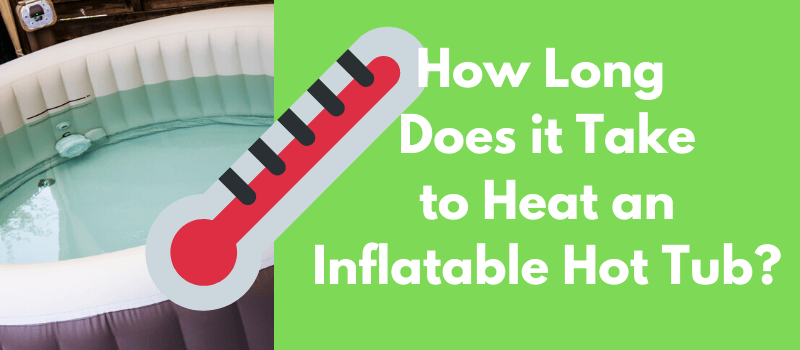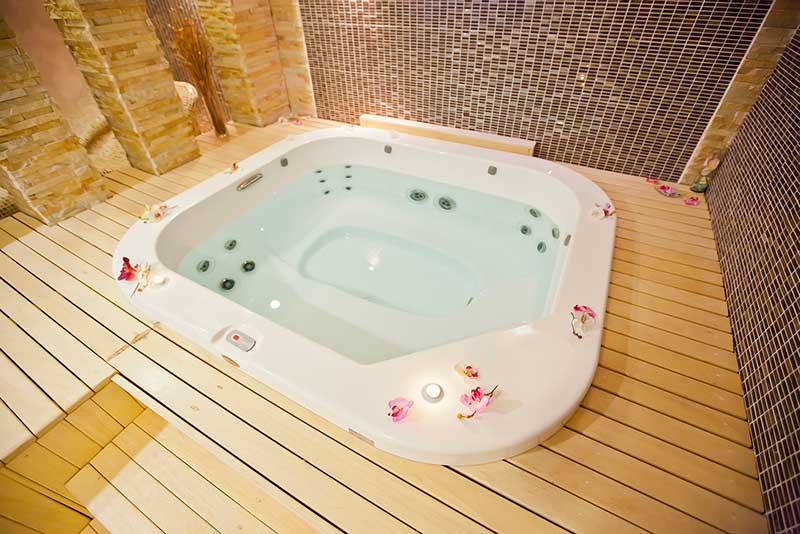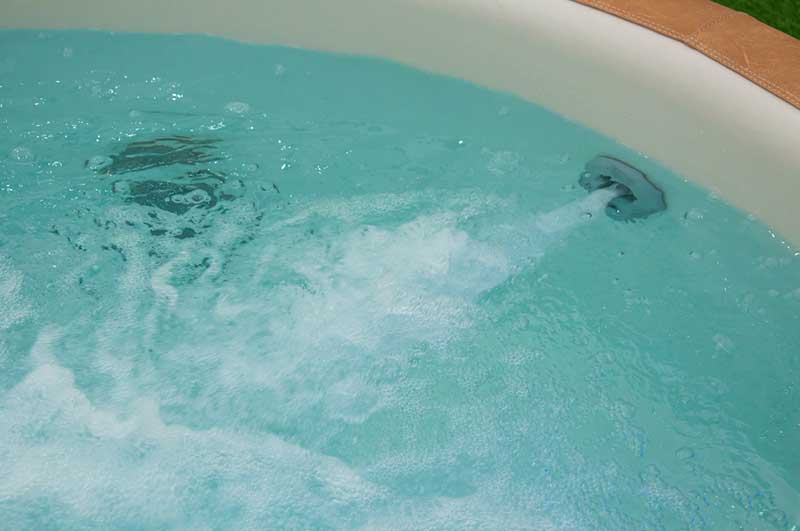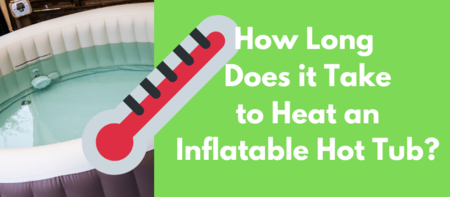
I’ve recently decided that I’d like to buy an inflatable hot tub, but I’ve found that I’ve got a lot of questions. One of the biggest questions I have is how long it takes to heat an inflatable hot tub – after all, I want to know how quickly I’ll be able to hop in and begin enjoying the spa experience!
So, how long does it take to heat an inflatable hot tub? You should expect it to take between 12 and 24 hours to heat an inflatable hot tub for the first time. This will vary, though, depending on the size of the model. A larger tub that is designed to hold more people will, of course, take longer to heat than a 2-person model.
There are other factors that are at play too. For example, the ambient temperature is also important – on a cold day, the water will take longer to heat than on a warm one. Also, once the pool has been heated, it will take considerably less time to reheat it to a usable temperature again. In this post, I’ll take a closer look at heating inflatable hot tubs and how to shorten the length of time taken to get the water to a comfortable temperature.
How Hot Should the Water in an Inflatable Hot Tub Be?
One factor to take into account when determining how long it will take to heat your inflatable hot tub is how hot you want the water to be. Every inflatable hot tub will have a maximum water temperature of 104 degrees Fahrenheit. However, if you select a slightly lower temperature of, say, 102 degrees Fahrenheit, it will take a shorter time to heat the water.
Not only that, but it’ll also save you money and energy. If you set the tub’s thermostat to 102 degrees Fahrenheit, you’ll not only save money when you heat the water for the first time, but you’ll also be saving money each time the water needs reheating. This could add up to a considerable sum over the course of the year.
Is It Safe to Set My Inflatable Hot Tub to a Lower Temperature?
If you’re considering choosing a lower temperature for the water in your inflatable hot tub so that it will take less time to heat up, you may be wondering whether it’s a safe solution. The good news is that, as long as you use sanitizing chemicals as recommended by the manufacturer, you shouldn’t experience any issues with water quality at a lower temperature.

Some people find that the maximum temperature of 104 degrees Fahrenheit is too warm for their preferences, while others are concerned about safety when small children or those with medical conditions like heart problems, pregnancy, or sensitive skin are using the tub.
Choosing a temperature of between 98 and 100 degrees Fahrenheit is a good idea in such cases, and could actually help the sanitizing chemicals to perform more effectively since they work better at a cooler temperature.
Do I Have to Fill the Inflatable Hot Tub with Cold Water or Can I Use Hot Water?
One way to shorten the length of time taken to heat your inflatable hot tub is to use hot water when you fill it in the first place. It will not only take less time to reach the appropriate temperature for use, but it’ll also be cheaper and save energy in the long run.
If you choose to do this, there are a few things you’ll need to do first:
- Cover the hot tub’s base with a layer of cold water before you add hot water
- Ensure you don’t add water that is hotter than 104 degrees Fahrenheit since this could damage the tub liner
- Never add any boiling water to make the temperature higher
There are also a few other issues with using hot water from the tap which I have covered in this post here. If you are considering this as an option give it a read as there are a few pitfalls with this solution.
Do I Need to Heat the Water in My Inflatable Hot Tub From Scratch Each Time I Use It?
If you’re only planning on using your inflatable hot tub infrequently, you should heat up the water from scratch each time you plan to use it. This means waiting for between 12 and 24 hours before you’ll be able to get into the tub. However, it isn’t cost-effective or practical to start heating the water from scratch every time if you’re planning to use it quite regularly.

Although it may sound counterintuitive to keep the tub’s heater running even when you aren’t using it, it makes sense in terms of convenience and also in financial terms. How? Well, if you’re going to use the tub on a regular basis – say, three or four times a week or more often – if you switch the motor off each time you finish using it, you’ll find the water temperature drops drastically and rapidly over the next day or so.
That means you’ll be heating the water virtually from scratch to your desired temperature each time you want to use it. Not only is that inconvenient, since you won’t be able to hop in whenever you feel like it, but it’ll also take more energy and cost more money to warm the water back to its target temperature if you do this.
On the other hand, if you leave the heater running constantly, the water will stay hot, and in the long-run, this will be more economical for you, not to mention more convenient for regular use. When you get out of the tub, set the digital control for the heater to about 96 degrees Fahrenheit.
This will ensure the water stays at a comfortable temperature. Then, around an hour before getting in the spa the next time, change the setting on the heater to your target temperature. When you hop in, you’ll find the water is an ideal temperature.
Will Covering My Inflatable Hot Tub Help to Keep it Warm?
It’s a fact that heat rises. With this in mind, it’s easy to see why you should always cover your inflatable hot tub when you’ve finished using it for the day and keep the cover on until just before it’s time to jump back in next time. You may be tempted to leave the cover off when you pop indoors to use the bathroom or to get a snack, but even for these short periods, it’s a good idea to put the cover back on. You’ll be surprised by how much heat you can preserve this way.
Every good-quality inflatable hot tub will come with a cover that is insulated to keep the heat in. Ensuring you use it correctly, keeping it securely fastened down for an airtight seal, will give you the best chance to keep your water warm.
It’s also important to regularly check the tub cover for any signs of aging or damage. This is particularly vital if the tub has been stored away during the colder months of the year. If you spot any cracks or holes, use a repair kit quickly to rectify the damage or your heating bills will increase and your water will get cold more quickly.
You’d be surprised to learn how much heat can be lost over a 24-hour period even though a tiny crack or hole in the tub cover, or if the cover hasn’t been secured properly. Therefore, make sure that you care properly for your inflatable tub’s cover and it’ll help to keep the water at a more comfortable temperature so that you don’t need to heat it from scratch each time you want to get in.
Thermal blankets can also make a big difference as they float on the water’s surface and prevent heat loss and evaporation.
Related Questions
Will building a shelter for my inflatable hot tub help to keep the water warm? One factor to bear in mind when keeping the water in your inflatable hot tub warm is wind chill. Whenever you’re in the tub, the wind will blow over the surface of the water, cooling and evaporating it. This means you’ll need to add more water to top up the level and use more energy to heat it back up.
Both of these things will cost you money and will add to the time taken to keep warm the water to the appropriate temperature. You can reduce the wind chill factor by adding a windbreak or suitable shelter around the tub. Consider putting it close to a hedge, wall or fence, or use shrubs, tall plants or privacy panels to minimize the problem of wind blowing on the water in your tub. As an added advantage, it can also make your inflatable hot tub more aesthetically pleasing.
Will insulating the bottom of my inflatable hot tub help to keep the water warm? Not only does heat rise, but it will also transfer to colder surfaces. That means that, when the water in your inflatable hot tub is at 104 degrees Fahrenheit, the heat will transfer from the base of the tub to the ground below it that is cooler.
This will cause the water to rapidly cool. As a result, it’ll take longer to warm the water to the right temperature again. Adding insulation under the hot tub will help to avoid this problem. Some hot tubs come complete with an insulated groundsheet. However, if yours hasn’t, you can buy one or use insulated foam sheets instead. It’s especially vital to put insulation under an inflatable hot tub when you’re planning to use it during cooler months of the year.

